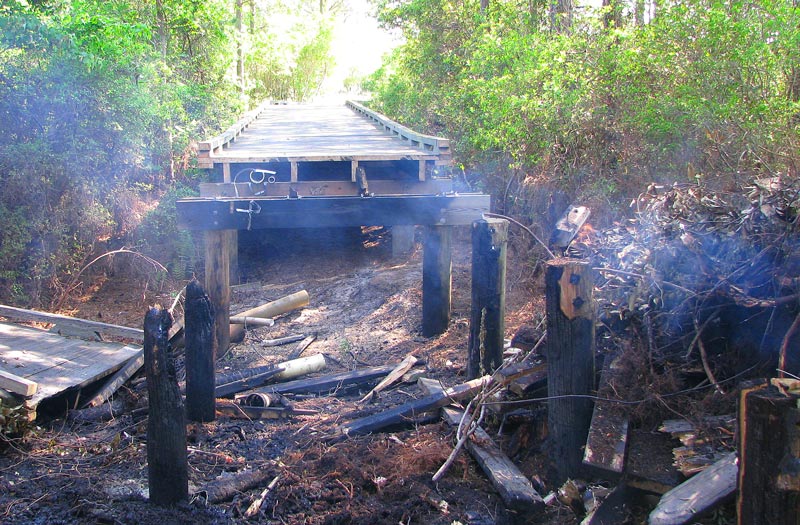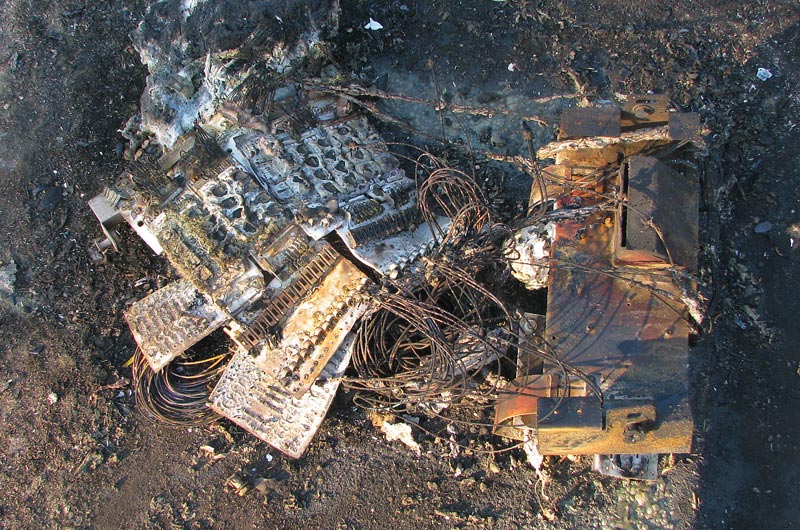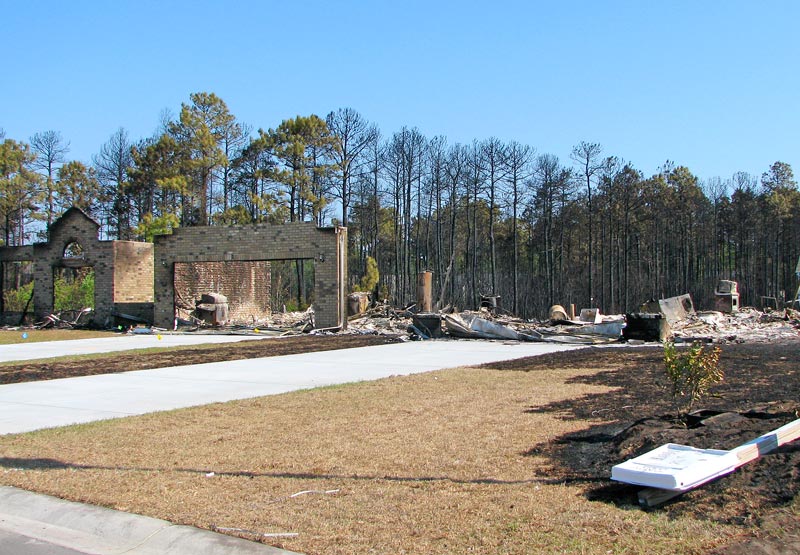
One of three bridges destroyed by a 2009 wildfire at Barefoot Resort in Myrtle Beach, S.C. Photo courtesy of Patrick Donelan
It was 2 o’clock in the morning in late April 2009 when the phone rang at the home of Patrick Donelan, CGCS, who at the time was the director of golf course maintenance for the 72 holes at Barefoot Resort in Myrtle Beach, S.C.
On the other end of the line was one of Donelan’s employees, who lived near the golf course in the Barefoot community, and he spoke a word every golf course manager dreads: fire.
But it wasn’t a fire in any of the structures on the property that the employee was warning Donelan about. It was something much worse: an out-of-control wildfire that threatened everything in its path.
Donelan had left the maintenance facility earlier in the night, thinking it was safe. The fire had been a source of concern for Myrtle Beach residents for several days, but it had seemingly been contained just south of Barefoot Resort. But the fire unexpectedly roared back to life and headed north, directly toward the property. Donelan, a 26-year GCSAA member, got to the maintenance facility just in time to watch the conflagration. There was little he could do at that point. Authorities had turned off all power to protect firefighters, and no power meant no water at the golf complex.
By sunrise, the fire had again subsided, this time for good. Damages could be assessed. As for the courses themselves, the fairways and greens emerged virtually unscathed — the well-irrigated turfgrass was hardly affected. But native grasses had burned, as did planted ornamentals. Planting beds covered with pine needle mulch were particularly susceptible to ignition from airborne embers. Many of the trees were evergreens, and the fire took a heavy toll on them.
In the end, only one of the four courses had to be closed to replace three bridges that had been lost. The Barefoot community was not so fortunate, however. Dozens of houses were destroyed by the fire, which would go down as the costliest in the state’s history.
On the other side of the country, Sandy Clark, CGCS, of Barona Creek Golf Club just outside San Diego had his own run-in with a wildfire in October 2003. Driven by winds that gusted up to 85 mph, a major fire moved in from the northeast. Power was quickly lost, and without the protection of irrigation, the fire moved into the golf resort. Much like what Donelan saw at Barefoot Resort, all the native areas between holes burned, but the irrigated turfgrass did not. As soon as the fire was extinguished and it was safe to return, the 21-year member of GCSAA and his maintenance team got to work, and the course reopened in just over a week.
Fuel for fire
What do golf course managers need to know about wildfires? Before a golf facility is developed, planners need to know whether wildfires are a concern in the area. Are there vegetation patterns that support fires, such as forests or open grassy or brushy areas? Do occasional weather systems produce situations that would bring a fire toward the facility? If the answer is yes to either question, fire can definitely be a problem.
To act as fuel for a wildfire, vegetation must be dry. When we think of wildfires, we typically think of drought. This can be the usual summer dry season on the West Coast, or it can be the periodic droughts common in other parts of the country.
Although drought is often a precursor to wildfires, it is not a prerequisite for major fires. In fact, the Myrtle Beach fire occurred with no preceding drought.
The fire season is defined as the period when fires are most likely to occur in a region — when vegetation is most likely to be dry. In the East, there are often two fire seasons, in spring and fall. These seasons tend to be drier in the East, and there is less shade from deciduous tree leaves. In the West, fire season starts in early summer and can extend through fall and into early winter, depending on when the winter wet season starts.

During a 2003 San Diego fire, Barona Creek Golf Club acted as a firebreak, preventing serious damage to the maintenance facility and a casino and hotel. Following the fire, erosion was a major concern on the hillsides where the dry native vegetation had been destroyed. Photo courtesy of Sandy Clark
When fuels are plentiful and dry, the next concern is an ignition source. The primary natural cause of wildfires is a dry lightning strike. These are very common in the mountains of the western U.S. north through Canada and especially into Alaska throughout the summer. Fires in other regions are usually a result of human activity, such as escaped campfires or debris burns, downed power lines, sparks from electrical equipment or even railroads, and even sometimes arson. As a general rule, when it’s dry, expect fires to start.
The impact of drought and terrain
Interestingly, the weather conditions that often come with drought normally will not promote the rapid-fire spread seen with major fires. Drought is usually associated with high pressure both at the surface and aloft. Winds are usually light. In relatively flat terrain and with adequate fuel, wind is a primary determinant of fire spread. Most major fires are associated with high winds, and these winds must be relatively dry.
As obvious as that may seem, in many regions, strong winds are often associated with storm systems that bring rain or snow. Strong, dry winds are unusual. High winds are produced by tight pressure gradients or large changes in pressure over relatively small distances, and they’re usually linked to surface lows and their attendant fronts. If moisture is available, clouds and precipitation will be the result.
If, however, a source of moisture is not available, a dry and windy weather system will be the result. In the eastern half of the country, winds out of the west and north tend to be dry. On the West Coast, things are reversed, with dry east winds often associated with fires. The Santa Ana winds of California are an excellent example. With wind speeds sometimes exceeding hurricane force and relative humidity in the single digits, the Santa Ana winds can make fire control impossible.
Interestingly, the Santa Ana winds are associated with high pressure areas located over the Great Basin. The clockwise flow produces the east winds off the arid and semi-arid regions, and the air is further warmed and dried by compression as it moves downslope.

Even before components of Barefoot Resort’s irrigation system were destroyed by wildfire, the system was rendered useless when authorities cut off power to the facility. Photo courtesy of Patrick Donelan
Rugged terrain brings in other complicating factors. Fire tends to burn faster upslope even without supporting winds. The wind itself can be modified and often enhanced by topography. Wind can be channeled and accelerated though canyons or valleys. Ridge tops can extend upward, where higher winds are common. Diurnal heating effects produce the characteristic upslope winds during the day and downslope winds at night. The 100,000-acre Station Fire near Los Angeles in August 2009 occurred with fairly benign winds. The rugged topography and heavy fuel load were the primary contributing factors to that fire.
Golf courses as firebreaks
After you’ve determined potential fuel sources and wind directions that can contribute to bringing a wildfire toward your property, you can determine firebreaks. Firebreaks are gaps in vegetation, which translate into gaps in fuel sources. Roads, rights of way, rivers, canals or other bodies of water all can stop a fire and make outstanding firebreaks. A major part of fighting fires is developing fire lines and firebreaks that can contain or stop the fire. The width of the firebreak will determine its effectiveness. Wind speed is also critical.
It must be noted that under the worst conditions, no firebreak or line will stop the forward progress of a major fire. The Myrtle Beach fire, for example, jumped a six-lane highway easily.
Interestingly, golf courses themselves can act as firebreaks. Well-watered fairways and greens along with breaks in tree canopies can stop a fire. In fact, during the 2003 San Diego fire, Clark’s course at Barona Creek acted as a firebreak, protecting the maintenance facility as well as the casino and hotel on the property from serious damage.
The National Weather Service provides regular forecasts of potentially dangerous fire weather conditions. Local NWS offices, in conjunction with the Forest Service, will issue “Red Flag” warnings when the combination of high wind, low humidity and low fuel moisture would significantly increase the risk of extreme fire behavior. Such warnings are issued just prior to the onset of such conditions, often in the morning. A “Fire Weather Watch” means Red Flag conditions may occur within 12 to 48 hours.
The three kinds of wildfires
There are three types of wildfires. Most start out as surface fires, during which the surface litter and other loose materials burn. Low vegetation also burns. Sometimes, the fire burns down into the organic material below the surface, producing a ground fire. Areas with deep organic layers, such as dried up wetlands, are prone to these slow-moving but long-lasting fires. Such fires can burn for weeks or even months.
Crown fires occur when a surface fire jumps up into the crowns of conifers. These are fast-moving, extremely dangerous fires. They often move much faster than the surface fire that started them. The fires of the western chaparral are also considered crown fires because they are within the crowns of the shrubs common there. These crown fires remain very close to the surface fire but, as experience has shown, can spread very rapidly.
One of the overlooked aspects of a wildfire and one that can be very dangerous is the fire’s vertical nature. Fires are three-dimensional systems. Above the surface fire, you have the convective column. Hot air rises hundreds or even thousands of feet upward. Burning debris and embers can easily be taken aloft, where the winds are often even stronger. They can then rain down well ahead of the main fire front. Here they can start new, spot fires.
With the Myrtle Beach Fire, embers came down a half-mile ahead of the main fire. In some extreme cases, spot fires have been ignited several miles ahead of the main fire front. What this also means is that fires don’t move continuously along the ground. They can jump ahead. As you can imagine, burning debris and embers falling from the sky present a real threat to buildings or flammable vegetation on a golf course.
Protecting your property
Is there anything superintendents and golf course maintenance teams can do to reduce the threat from fires? Unfortunately, there isn’t much. Both Donelan and Clark said removal of brush and debris lessens fuel sources, but those are fairly standard practices on most golf courses anyway.
Do Donelan or Clark think they could have done anything to lessen the damage done by the two fires? Probably not.
A wildfire of the magnitude seen in Myrtle Beach and San Diego cannot realistically be stopped. Donelan said that if he had known exactly where the fire was going to approach from, he could have concentrated more water there. But in his case, the more general watering was sufficient to help blunt the fire. Another option, he suggested, was generators that could have allowed water to still be pumped even when the power failed, but this is a costly option and the benefits may not justify the expense.

Houses in the Barefoot Resort community in Myrtle Beach, S.C., didn’t fare as well as the golf course did in the 2009 fire. Photo courtesy of Patrick Donelan
Clark went a step further and suggested the installation of water cannons that would be tied into the irrigation system. They could shoot water out farther, in essence extending the firebreak created by irrigated land.
The aftermath of a fire also presents its own set of problems. In the days immediately following a fire, hot spots can flare up within the burned area and need to be carefully monitored. Smoke was a major concern for a number of days after both the Myrtle Beach and San Diego fires, reducing visibility to dangerous levels. Ash covered almost everything and had to be cleaned up. Charred trees had to be cut down for both safety and aesthetic reasons, and burned debris had to be removed.
In Clark’s part of the world, a major concern following the fire was erosion on the hilly terrain after the rainy season started. Another negative factor was the perception among golfers that the fire had significantly damaged the courses. Phone calls from prospective guests indicated that this did cause some loss of business.
On the positive side, Donelan said he did learn a lot about the golf course community in Myrtle Beach after the fire, when he was overwhelmed with support from vendors and other superintendents.
Ed Brotak, Ph.D., was a longtime professor of atmospheric sciences at the University of North Carolina Asheville.